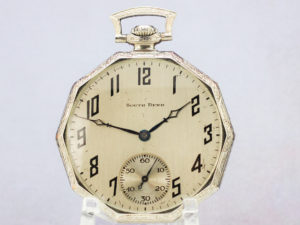
In 1900, Webb C. Ball set the standards for railroad pocket watches – timepieces that kept America’s train network safe and reliable, elevated horological standards and made the Cleveland jeweler a wealthy man. Some 120 years later, the Ball Trainmaster Secometer pays homage to the Swiss-owned watchmaker’s roots. Does it keep the faith? . . .

The first thing you notice about the Ball Trainmaster Secometer: it’s small. The Secometer’s case diameter is 45mm – the same size as your average Panerai wristwatch.
Historically speaking, the Secometer’s roughly the same size as ye olde size 12 pocket watch. Back in the day, American manufacturers like Elgin, Hamilton and Illinois cranked out millions of size 12’s as “men’s dress watches.” Now? Not so much.

Like pickup trucks, all watches are larger these days. Most vintage pocket watch collectors favor size 16 and 18 timepieces – not-so-coincidentally the only sizes allowed by Mr. Ball’s mandatory railroad watch standard.
As someone who daily carries a pocket watch, the new Ball Trainmaster Secometer makes my hand look like André the Giant’s, while my go-to silver pocket watch chain looks like a tugboat rope tied to a chihuahua.

The text at the top of the new Secometer – “Railroad Standard since 1891” – is Ball’s trademark. Although the Ball Watch Company became synonymous with railroad watches – creating the expression “on the ball” – the diminutive Secometer wouldn’t meet Webb’s criteria for a Lionel train set.

I’d never seen the vintage Art Deco Secometer before Ball posted its picture on their website. Although the reissue shares the same basic design, the original differs from its modern iteration in several details.
The antique’s curved logo lacks the official trademark. The design motif above and below its secometer rotating disc is more ornate than its latter day “re-imagining.” And the vintage pocket watch’s minute hand is a simple sword – as opposed to the new watch’s more elegant skeletonized minute hand.

The new Secometer’s triangular indices are lumed like the original’s – replacing toxic radium with faux vintage Super-LumiNova. Strangely, the Secometer’s hands aren’t lumed – rendering the pocket watch unreadable in low to no light.
Equally lamentable, the Ball Trainmaster Secometer’s case lacks the vintage pocket watch case’s engraved flair. Aside from the Deco-style numbers around the bezel, it has no flair whatsoever.

In fact, it you set out to make a thoroughly pedestrian case for a pocket watch, you could do no better/worse than the new Secometer’s solution.
The Secometer’s encased in an entirely charmless stainless steel fingerprint magnet. The undecorated bow flops around like a dead fish. The case is sealed shut but good, keeping the BALL RR2102 movement within from public view.

It’s too bad that prising upon the case with a knife voids the warranty (bye-bye 30m water resistance). Judging from the PR pic, the Secometer’s BALL RR2102 caliber manual wind movement isa sturdy Geneva-striped engine.
While a 17 jewel pocket watch isn’t inherently inferior to more be-jeweled movement, collectors are jewel sluts. They also appreciate a winding mechanism that moves like a curling stone on ice. The Secometer’s movement is suitably smooth and precise, but it’s too tight, like it’s waiting for the mainspring to relax.

Putting the Secometer on the Timegrapher – bow up – yields a magnificent +1 second a day deviation – well within the old railroad watch standard of +/- 30 seconds a week.
Laid flat, the accuracy drops to +12 seconds a day. Not so adjusted now, eh Mr. Bond? Still, as a timekeeper, the modern day Secometer is a perfectly reliable companion.

At a very high price.
The Pocket Watch Guy sells a fully serviced and adjusted size 12 Art Deco Illinois pocket watch with blued steel hands (above) for $675.
The Ball Trainmaster Secometer sucked $775 out of our editorial budget – for a pocket watch with none of the 1927 Illinois’ history, case class and sophistication.

Ball’s decision to revive their pocket watch tradition with a small, expensive, blandly cased pocket watch resurrecting an obscure Art Deco piece was the wrong answer.
A 21-jewel size 16 or 18 pocket watch embodying Mr. Ball’s railroad grade spirit – as ALL of Ball’s wristwatches do – would find a ready market. Well, I know of at least one customer ready to trade.
Model: Ball Trainmaster Secometer
Price: $749 direct from manufacturer (no commision on link)
SPECIFICATIONS:
Case size: 45mm
Case Height: 12mm
Case material: Stainless steel
Crown: Pushed-in
Movement: Stem-set manual caliber BALL RR2102
Weight: 2.6 ounces
Water Resistance: 30m/100ft.
Crystal: Anti-reflective sapphire crystal
RATINGS (out of five stars):
Design * * *
An unassuming, note-for-note recreation of a Ball Art Deco pocket watch with a surgically boring case and luminous indices – that somehow forgot to lume the hands.
Legibility * * * *
The stylish hands and railroad track rehaut make time-telling easy enough, but again, one deficiency lumes large. Or should do.
Accuracy: * * * * *
Plus or minus one second a day accuracy is as good as it gets, and more than good enough for daily pocket watch carry.
Overall * *
A sturdy “gentleman’s pocket” watch that desperately needs a more flamboyant case and/or a lower price tag – especially when compared to top quality vintage pieces.
Courtesy of The Truth About Watches

